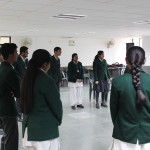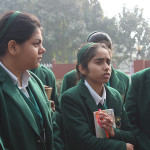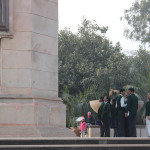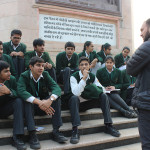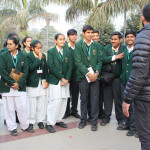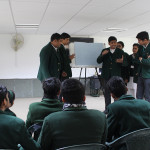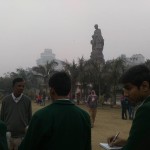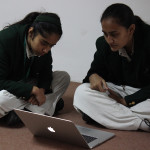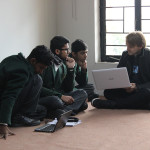We started the year with the Memory Walk project at Ludhiana, facilitated by Aaron Peterer and Yan Paul Dubbelman from the Anne Frank House. The project then went to Patna, where we worked with 15 high school students from Delhi Public School, Patna.
The first day of the workshop began with a fun exercise, where first, each of the participants had to arrange themselves in a circle according to their date of birth and month. This was followed by showing off their coolest dance moves, which had to be repeated through the circle. Not only fun but also a great way to warm up on a cold winter morning!
The participants then paired off, each doing a short interview of the other. The interview comprised of fairly basic questions like the persons name, the meaning of the name and if there was any funny story associated with the name. Some of the stories were pretty hilarious, with most of the participants recounting mispronunciations. Interestingly, the exercise only involved the first names; given that we are constantly forming impressions based on names and particularly, with the prevalent caste system in India, last names.
A discussion followed the screening of the documentary ‘A Short Life of Anne Frank’. The participants spoke about their impressions of Anne and her life after watching the film. They mentioned her characteristics—optimist, mature and her determination to continue to write. The group then went on to discuss how she would describe her friends and that it showed that she was just a ‘normal human being with ‘normal’ human feelings. Her diary is very relatable, wherever one is and whatever situation one is in. The discussion then moved on to why the Anne Frank story is still relevant. Participants mentioned the relevance in terms of human rights situations nowadays. Discrimination nowadays was classified under the broad categories of caste, religion and gender. The participants then went on to write, on post-its, two words that came to their minds when they hear the word ‘monuments’. Of course, many found it hard to restrict themselves to just one word! We then moved onto a PowerPoint on memorials, which included the roles played by the different stakeholders (for example, the Government, artists, activists, victims and survivors and so on) and the different ways by which one can remember war and conflict. The afternoon was spent at four sites of memorialization in the city. Each of the sites were bang in the middle of the city, very different to the previous Memory walk workshop in Ludhiana, where the interviews were conducted in narrow lanes and by lanes and the concept was quite intangible.
Day two began with an introduction to the day and the sites to be worked on. The monuments that were chosen were the Ambedkar statue (1) near the High Court and the Gandhi statue (2) in Gandhi maidan. The participants then went into a discussion on why Memory Walk is done and the purpose served by the monuments that had been picked for the project. We discussed the essence of rights and rights today. A few students shared the misgivings that they had with regards to reservations for Scheduled Castes and Scheduled Tribes. I thought that the fact that they could speak about these concerns was in itself an important development.
The participants then split up into groups and worked on the ‘Ideal Monument’, based on the two monuments that were chosen for the project. Both groups mostly worked on changing the physical nature of the monument. The group working on the Gandhi monument added features such as lights, souvenir shops etc. with the aim of generating revenue from the statue and encouraging tourism in the area. The group working on the Ambedkar statue changed the structure of the gate, in order to make it more accessible to the public and also added signs in English—keeping in mind the discussion the previous day about how the signs were all in Hindi, a feature that would definitely limit the accessibility, particularly for tourists. To me, it also showed a definite bias towards the Hindi language, after all, Hindi is not the only language spoken in India. There was, in both groups, a great deal of debate, throwing out of ideas, returning to the drawing board and agreeing to disagree. After the presentation, the groups then began working on the questions that they would ask during the filming. This proved very challenging as the participants worked out how to ask questions that were open ended and not leading.
After the groups had their questions ready and a plan of action, we set out to the monuments to take the interviews. Team Ambedkar statue/ Team Paul first took shots of the Ambedkar statue and then we all went to the Gandhi maidan where the teams split up. The reasons for choosing the Gandhi maidan for filming were practical: there was just too much sound (traffic, mainly) around the Ambedkar statue and being a Sunday, there was likely to not be very many people. Gandhi maidan was of course choc-a-block full. It was Sunday as well as Makar Sankranti (3). Despite the cold weather, there were families, groups of friends and so on, flying kites and spending quality time together. Team Gandhi statue/ Team Aaron was quick off the block in terms of getting interviewees. Some of the answers were quite interesting. The people spoke about how of course, there was still discrimination (when asked if Gandhi’s dream of an India with no discrimination had been fulfilled) and one gentleman even asked the participants if what they were doing (making a film) was really enough to bring about change. One woman was vocal about the fact that the statue, to her, was a huge waste of money. The participants were thrilled with different kinds of voices they were able to record.
Day three was spent in the school, in groups—working out how to edit the footage that was shot the previous day. Aaron and Paul showed the groups the basics of Final Cut Pro and the students set to work. The groups not only had to work out their script—in terms of the introduction and what clips or stills they would include, but also edit the footage they had from the previous day—to make a short film. Of course, the Anne Frank House team would put in the finer touches and the subtitles later.
I wasn’t able to stay till the end of the workshop, but I did have a number of thoughts that stayed with me. One was that this kind of a workshop was completely new for the participants and the school. It gave them (and me) the chance to think about monuments—what they see almost on a daily basis, in a completely new light. I almost instinctively started thinking about monuments in Calcutta, questioning why, when and how as well the relevance they have in the world today. I did feel that the students were only just beginning to start to analyse and to critically examine the relevance of monuments and remembrance and while they have a long way to go, the beginning is just as important. I also noticed the fact that the participants worked in groups, in as cohesive a manner as possible, despite not knowing each other very well at the start of the workshop.
Notes
(1) Bhimrao Ambedkar, popularly known as Baba Saheb Ambedkar was a social reformer, politician and economist. He fought against the caste system and for the rights of Dalits. The statue that the students worked on as part of the Memory Walk project is located outside the Patna High Court.
(2) This statue, located in Gandhi Maidan is the world’s tallest statue of Mahatma Gandhi. It is 72 feet high and made of bronze.
(3) Makar Sankranti is the harvest festival and is celebrated all over India.
–Paroma Sengupta

